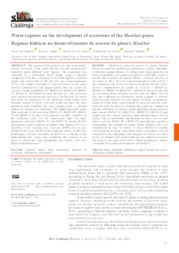Water regimes on the development of accessions of the Manihot genus.
Water regimes on the development of accessions of the Manihot genus.
Autoria: SOBREIRA, A. M.; SIMOES, W. L.; NUNES, G. H. de S.; SILVEIRA, L. M. da; ANTONIO, R. P.
Resumo: The objective of this work was to select water deficit-tolerant accessions of the genus Manihot, through morphological characters under different water regimes. The experiment was conducted in a randomized block design, using a split-plot arrangement with plots consisting of tree water regimes (simulated rainfall and water depth of 100 and 20% crop evapotranspiration (ETc)), and subplots consisting of eight accessions of the genus Manihot(Gema-de-Ovo and Engana-Ladrão from the species M. esculenta Crantz, and BGMS-115, BGMS-110, BGMS-102, BGMS-79, BGMS-24, and BGMS-48 from Manihot sp.). The accessions were evaluated considering two crop cycles: the first had 120 and 60 days from the application of the treatments. Plant height, stem diameter, number of leaves, leaf lobe length and shoot dry mass production were evaluated. For each cropping cycle, a split-plot analysis of variance was performed. The highest genotypic means were expressed by the accessions BGMS-115, BGMS-102, BGMS-79 and BGMS-24 for most of the analyzed variables, regardless of the cultivation cycle. For the characteristic shoot dry mass production, accessions BGMS-102 and BGMS-79 showed the best performances under conditions of limited water regime (20% ETc), regardless of the cropping cycle. Accession BGMS-102 was also grouped in the group with the highest genotypic means, for this trait, in treatments with rain simulation and 100% ETc, in the first cycle, demonstrating that, under stress conditions, this accession is an option to tolerate low water precipitation and responds well when higher precipitation occurs.
Ano de publicação: 2023
Tipo de publicação: Artigo de periódico
Unidade: Embrapa Semiárido
Palavras-chave: Gênero Manihot, Mandioca, Manihot Esculenta, Morfologia Vegetal, Seleção de acessos, Semiárido, Solo, Tolerância ao déficit hídrico
Observações
1 - Por padrão são exibidas publicações dos últimos 20 anos. Para encontrar publicações mais antigas, configure o filtro ano de publicação, colocando o ano a partir do qual você deseja encontrar publicações. O filtro está na coluna da esquerda na busca acima.
2 - Para ler algumas publicações da Embrapa (apenas as que estão em formato ePub), é necessário ter, no celular ou computador, um desses softwares gratuitos. Sistemas Android: Google Play Livros; IOS: iBooks; Windows e Linux: software Calibre.
Acesse outras publicações
Acesse a Base de Dados da Pesquisa Agropecuária (BDPA) para consultar o acervo completo das bibliotecas da Embrapa.

